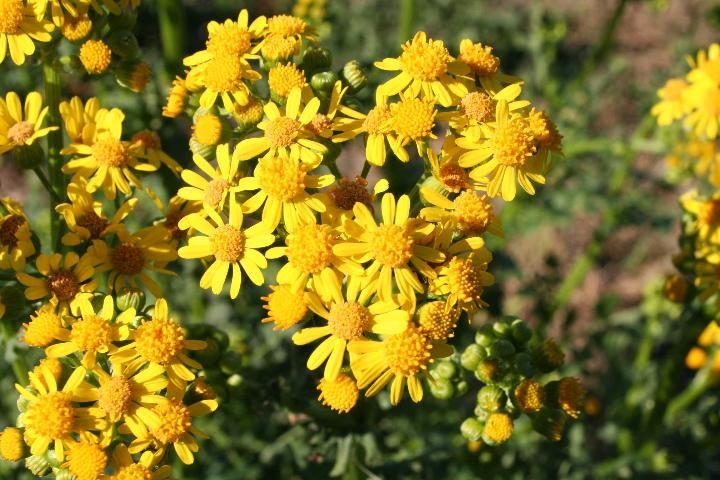The number of calls about a succulent plant with many yellow flowers has increased over the past several years. In certain cases, the infestation has been so severe that the pasture looks like a sea of yellow in April and May. While dealing with row crops, we tend to think of wild radish when we see a sea of yellow flowers. In fact, the plant infesting pastures during the late winter and early spring is commonly known as butterweed or cressleaf groundsel (Packera glabella, formerly known as Senecio glabellus).
Butterweed is a winter annual that starts to emerge as early as November in certain areas of the state. It tends to prefer moist soils, so its presence in low-lying areas in pastures is quite common. It initially grows as a rosette with leaves oppositely arranged on the stem, but it may appear to have whorled leaves because the internode length on the stems tends to be fairly short (Figure 1). Leaves of this plant tend to be deeply lobed, except at the seedling stage, when the leaves are nearly entire (without lobes). As the flowering stalk elongates, the stems become ribbed with red or purple streaks (Figure 2). The leaf arrangement becomes alternate on the succulent and hollow stems. Butterweed is typically not recognizable until it begins producing several bright yellow flowers on its stems. Individual flowers, like many of those in the aster family, have both inner (disk) and outer (ray) flowers (Figure 3). Butterweed will have 5 to 15 outer ray petals, making this species distinct from mustards, which only have 4 petals in a cross-like arrangement. Seeds (achenes) contain a white feathery pappus, or tuft of hair, that aids in wind dispersal and spread of the plant.

Credit: B. Sellers, UF/IFAS

Credit: B. Sellers, UF/IFAS

Credit: B. Sellers, UF/IFAS
Butterweed is toxic to both cattle and horses. It is known to cause liver disease in cattle, producing symptoms such as listlessness, decreased appetite, and photosensitization in extreme cases. Horses frequently appear uncoordinated, become entangled in fences, and awkwardly bump into objects after ingesting the plants. Cattle that consumed 4 to 8% of their body weight in green plant over a few days developed acute liver necrosis and died within 1 to 2 days. Cattle that ingested 0.15% of their body weight (fresh weight) of a species in the same genus as butterweed for a minimum of 20 days resulted in 100% mortality. This equates to a 20-day cumulative dose of 2% of an animal's body weight of dry plants (Knight and Walter 2001). It also appears that this species has been responsible for abortions in cattle, making control of butterweed a necessity.
It is common to see butterweed at all stages of growth in late February to late March. Control of butterweed is successful with 2,4-D during the rosette growth stage. That said, more than one application of 2,4-D may be necessary in certain situations due to its limited residual activity. We have observed excellent control of butterweed with GrazonNext HL at 24 oz/acre or Milestone at 3 to 5 oz/acre during all growth stages.
If you have seen this toxic weed in your pastures, you should scout those pastures every winter. Timely herbicide applications will help prevent poisoning of your cattle and horses. If you have additional questions concerning this species, please contact your local county Extension agent.
Reference
Knight, A. P., and R. G. Walter. 2001. A Guide to Plant Poisoning of Animals in North America. Jackson: Teton New Media.